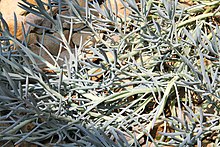| Flat-leaved senecio | |
|---|---|

| |
| In the Karoo Desert Botanical Garden, Western Cape, South Africa | |
|
Scientific classification
| |
| Kingdom: | Plantae |
| Clade: | Tracheophytes |
| Clade: | Angiosperms |
| Clade: | Eudicots |
| Clade: | Asterids |
| Order: | Asterales |
| Family: | Asteraceae |
| Genus: | Curio |
| Species: | C. ficoides
|
| Binomial name | |
| Curio ficoides Curio ficoides (
L.) & P.V.Heath (1999)
| |
| Synonyms | |
|
Cacalia ficoides L. | |
Curio ficoides, syn. Senecio ficoides, also known as skyscraper senecio, Mount Everest senecio or flat-leaved senecio, is a species of succulent plant, in the genus Curio ( Asteraceae), indigenous to South Africa.
Description


A succulent, spreading shrub, it reaches over 1 meter in height. The brittle, succulent branches lose their leaves lower down. The leaves are blue-green to blue grey, pruinose, succulent, erect, tapering and flattened laterally, with translucent lines down both sides. The flower capitula have no ray florets, and appear on a terminal, branching inflorescence.
Relatives
This is a polyploid species (2n=100). However, its closest relatives are Curio repens, Curio radicans, Curio herreanus, and Curio hallianus, which have a variable number of chromosomes.
It is easily confused with Curio talinoides, which has a similar growth habit. However, the leaves of C. talinoides are rounded-cylindrical in cross section. In contrast, the leaves of C. ficoides are usually somewhat knife-like, flattened laterally. [3]
References
-
^
International Plant Names Index (IPNI).
Royal Botanic Gardens, Kew;
Harvard University Herbaria &
Libraries;
Australian National Botanic Gardens. 2008-05-24
https://www.ipni.org/n/245108-1.
{{ cite web}}: Missing or empty|title=( help) - ^ "Senecio ficoides (L.) Sch.Bip. record n° 98122". African Plants Database. South African National Biodiversity Institute, the Conservatoire et Jardin botaniques de la Ville de Genève and Tela Botanica. Archived from the original on 2013-01-16. Retrieved 2008-05-24.
- ^ G. Rowley (1994). Succulent Compositae: A Grower's Guide to the Succulent Species of Senecio & Othonna. Strawberry Press. ISBN 0912647124, 9780912647128
External links
![]() Media related to
Curio ficoides at Wikimedia Commons
Media related to
Curio ficoides at Wikimedia Commons
- UniProt. "Senecio ficoides". Retrieved 2008-05-24.
| Flat-leaved senecio | |
|---|---|

| |
| In the Karoo Desert Botanical Garden, Western Cape, South Africa | |
|
Scientific classification
| |
| Kingdom: | Plantae |
| Clade: | Tracheophytes |
| Clade: | Angiosperms |
| Clade: | Eudicots |
| Clade: | Asterids |
| Order: | Asterales |
| Family: | Asteraceae |
| Genus: | Curio |
| Species: | C. ficoides
|
| Binomial name | |
| Curio ficoides Curio ficoides (
L.) & P.V.Heath (1999)
| |
| Synonyms | |
|
Cacalia ficoides L. | |
Curio ficoides, syn. Senecio ficoides, also known as skyscraper senecio, Mount Everest senecio or flat-leaved senecio, is a species of succulent plant, in the genus Curio ( Asteraceae), indigenous to South Africa.
Description


A succulent, spreading shrub, it reaches over 1 meter in height. The brittle, succulent branches lose their leaves lower down. The leaves are blue-green to blue grey, pruinose, succulent, erect, tapering and flattened laterally, with translucent lines down both sides. The flower capitula have no ray florets, and appear on a terminal, branching inflorescence.
Relatives
This is a polyploid species (2n=100). However, its closest relatives are Curio repens, Curio radicans, Curio herreanus, and Curio hallianus, which have a variable number of chromosomes.
It is easily confused with Curio talinoides, which has a similar growth habit. However, the leaves of C. talinoides are rounded-cylindrical in cross section. In contrast, the leaves of C. ficoides are usually somewhat knife-like, flattened laterally. [3]
References
-
^
International Plant Names Index (IPNI).
Royal Botanic Gardens, Kew;
Harvard University Herbaria &
Libraries;
Australian National Botanic Gardens. 2008-05-24
https://www.ipni.org/n/245108-1.
{{ cite web}}: Missing or empty|title=( help) - ^ "Senecio ficoides (L.) Sch.Bip. record n° 98122". African Plants Database. South African National Biodiversity Institute, the Conservatoire et Jardin botaniques de la Ville de Genève and Tela Botanica. Archived from the original on 2013-01-16. Retrieved 2008-05-24.
- ^ G. Rowley (1994). Succulent Compositae: A Grower's Guide to the Succulent Species of Senecio & Othonna. Strawberry Press. ISBN 0912647124, 9780912647128
External links
![]() Media related to
Curio ficoides at Wikimedia Commons
Media related to
Curio ficoides at Wikimedia Commons
- UniProt. "Senecio ficoides". Retrieved 2008-05-24.